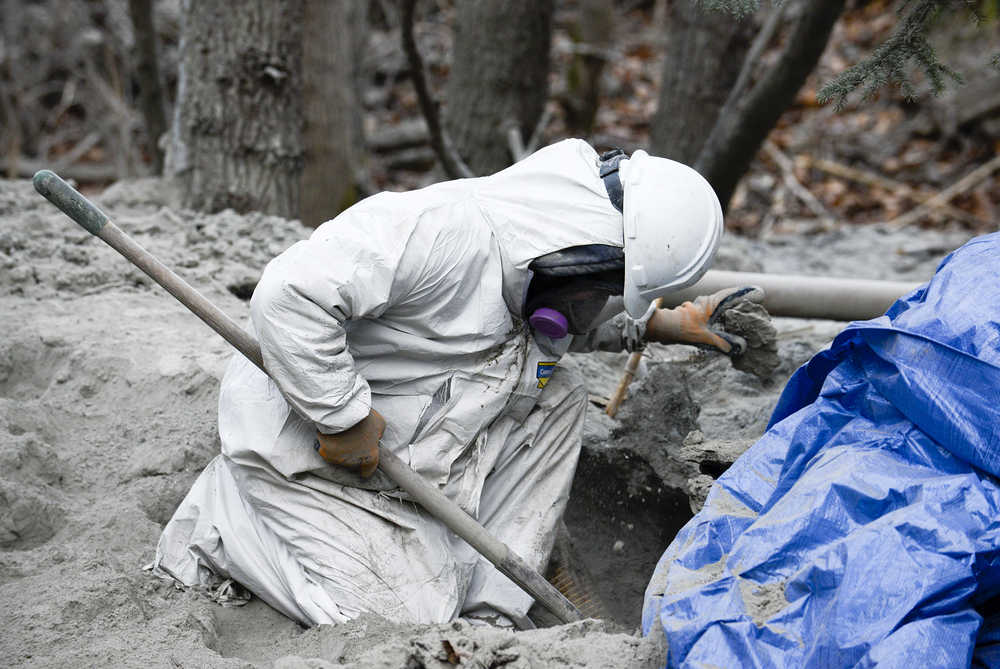Between the intermittent noise of an industrial truck-mounted vacuum running for several hours a day, a cleanup crew in hazmat suits moving the through the woods near his property and his general discomfort with the whole situation, Chuck Campbell has not been getting any work done.
Contractors and employees of a Nikiski-branch of the behemoth oilfield services company, Baker Hughes, have been working to clean up a cement mixture that workers had dumped in the woods adjoining Campbell’s property. An Alaska Department of Environmental Conservation investigator said the cleanup is expected to be complete by the end of the week.
The 61-year-old Ninilchik man sat on a log sharpening two of his chain saws Wednesday. Wood piles loom large on Campbell’s lot which he uses as the base for his logging company. Several logging apparatus, a half-finished log cabin, a trailer, and several other vehicles dot the property where Campbell said he typically works a few days a week before returning to his Ninilchik home.
That all changed in late October after Campbell discovered a growing pile of dusty, white residue while hunting on his property. For some time, workers at Baker Hughes had been driving to the east end of the company’s lot, and dumping the remnants of the cement mixture down a dirt hill and into the woods — a clear violation of the company’s recommended disposal method for the mixture, according to its data sheet for the material. Several feet of the material encroach on property Campbell owns and, a long thin trail of it has streamed into a pit where Campbell had planned to sink a well for drinking water.
At the time, a Baker Hughes communications specialist, Dana Morrison, wrote in an email that the company did not believe the cement was a risk to human health or the environment.
Despite repeated requests to multiple employees, no one from Baker Hughes provided the Clarion a copy of the company’s material safety data sheet, or MSDS, on the cement-compound.
Campbell said the company also refused to provide him with a copy of the sheet.
“They almost handed me one and then they took it back,” he said during a previous interview.
A material safety data sheet contains company-specific information about its products and is designed to provide workers and others with procedures for handling substances safely.
The company did provide an MSDS to the Alaska Department of Environmental Conservation, or DEC. According to that sheet, the cementing material is considered hazardous by Occupational Safety Health Administration, or OSHA, standards. The sheet lists the spilled material as Cement Type I and it contains gypsum, calcium carbonate, calcium oxide, magnesium oxide, and a silica material according to the data sheet.
Acute overexposure can be corrosive internally and externally, and potential long-term heath effects to overexposure include organ damage and chronic respiratory irritation, according to the data sheet.
If the material is spilled, it is not safe to touch or walk through the substance and, according to the data sheet, the concrete material should not come in contact with soil, waterways, drains or sewers.
In the days since the spill was first reported, Baker Hughes has given DEC investigators a rough timeline of when its cleanup efforts will be completed, said DEC Environmental Program Manager Steven Russell.
According to state law, the company is required to submit a final report on the incident — including the results of lab testing of the material which is required by the DEC — within 15 business days of completing its cleanup.
However, it can be hard to determine exactly how long cleanup could take, Russell said. His co-investigator, DEC Environmental Program Specialist Jade Gamble has been providing him with regular updates on the company’s progress, Russell said.
After cleanup, DEC investigators will revisit the site and determine if any further lab tests are needed.
“We want the best picture we can get to see the effects that the material has had on the surrounding property,” Russell said.
On Wednesday, Campbell stood on the dirt hill near a wooden stake that marked the border of his property with the Baker Hughes lot. He has called a lawyer, and both a surveyor and materials testing company that will be have visited his property since then.
He looked at a row of large white bags, filled with the cement mixture being vacuumed out of the woods and shook his head.
“There’s just so much of it,” he said.
Each of the approximately 15 bags currently on Baker Hughes’ property can hold up to 1 cubic yard of material, Russell said.
Depending on the composition of the material, a cubic-yard of dirt could weigh more than 1,000 pounds.
“It’s several feet deep. Once they started digging it was clear that there was a lot more there than I thought,” Campbell said.
The sheer volume of material surprised Gamble as well, Russell said.
Several people have contacted Russell about the cleanup process and, he said he doesn’t fault Campbell for hiring a lawyer to sort through the process.
“It is everybody’s responsibility to occasionally look over the (neighbor’s) fence once in awhile and see what’s going on,” he said. “Don’t wait too long before going and knocking on the neighbor’s door to say ‘what’s going on here?’”
Rashah McChesney can be reached at rashah.mcchesney@peninsulaclarion.com

